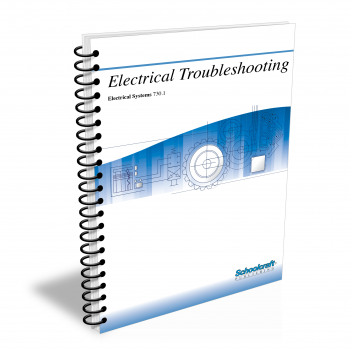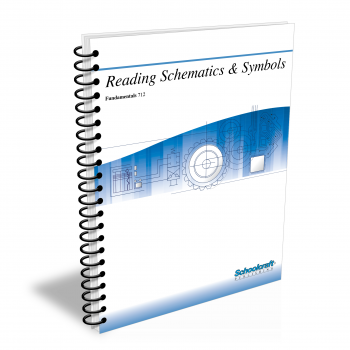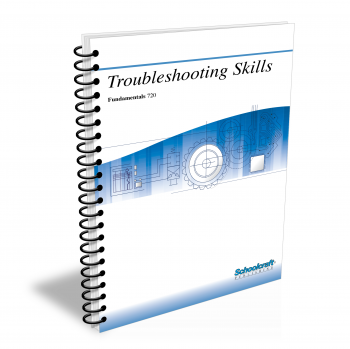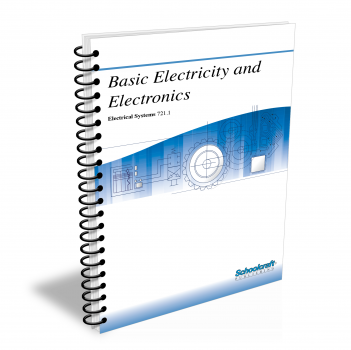Electrical Troubleshooting

Course Number: 730.1
The Electrical Troubleshooting textbook covers use of schematic diagrams, determining sequence of operation, and the use of building diagrams and single-line diagrams. It includes troubleshooting procedures for control circuits and combination starters and explains troubleshooting practices on DC and AC motors, identifying unmarked leads on three-phase delta and Y-connected motors, and troubleshooting lighting systems.
Does your curriculum require additional topics not included in this textbook? Build a customized version of the Electrical Troubleshooting textbook below.
This textbook has been recently updated
to include topics lists, objectives, & key terms for every chapter.
Recommended Contact Hours – 15
Preview a Chapter
Available Supporting Material
- Table of Contents
- Exam Copies
- Suggested Titles
Table of Contents
Chapter 1: Troubleshooting with Electrical Schematics
Topics: Symbols; Elementary diagrams; Power control and motor-starting circuits; Identifying conductors; Control panel layout; Sequence of operation
Learning Objectives:
- Identify a control relay on an electrical schematic.
- State the NEC requirements for fuses in ungrounded conductors.
- Explain component numbering on electrical schematics.
- Explain how conductors in a motor-control circuit are identified.
Chapter 2: Troubleshooting with Building Drawings
Topics: Architectural drawings; Installation diagrams; Electrical symbols on blueprints; Substation and power-installation drawings; Circuit tracing
Learning Objectives:
- Name the kinds of drawings used by electrical specialists.
- Identify electrical symbols commonly used for building diagrams.
- Describe a one-line diagram.
- Discuss the different types of drawing characteristics.
Chapter 3: Troubleshooting Control Circuits
Topics: Control-circuit functions; Conditions of protection; Troubleshooting pushbutton, sequence/control, motor, and overload circuits
Learning Objectives:
- Explain how severe three-phase voltage unbalance affects a three-phase motor.
- List the advantages of inherent protection.
- Explain how undervoltage release works.
- Describe how to troubleshoot a motor circuit.
Chapter 4: Troubleshooting Combination Starters
Topics: Using relay-troubleshooting charts; Latching-relay and timing-relay checks; Replacing relay coils; Troubleshooting control circuits, starters, and relays
Learning Objectives:
- List the reasons why a magnet coil burns or short-circuits.
- List the steps in troubleshooting a defective motor.
- Explain how a mechanical latching relay works.
- Explain how an electronic timing relay operates.
Chapter 5: Troubleshooting Control Devices
Topics: Reversing controllers; Using a checking-sequence chart; Autotransformer starters; Multi-speed motor starter controls
Learning Objectives:
- Demonstrate how to reverse the rotation of a three-phase induction motor.
- Explain the function of limit switches in reversing-motor applications.
- Describe how to use a checking-sequence chart.
- Select the best starter for use where it is undesirable to put a heavy load on the power supply.
- Explain how to change the speed of a squirrel-cage motor.
Chapter 6: Troubleshooting Special Controls
Topics: Selenium rectifiers; Testing rectifier diodes and three-phase rectifiers; Control-system logic; Static control; Time delay element
Learning Objectives:
- Explain the effects of age on a selenium rectifier.
- Name the protective devices used in electrical systems and pneumatic systems.
- State the definition of a bistable device.
- List the functions of a static control device.
Chapter 7: Troubleshooting DC Motors
Topics: Commutator discoloration; Brush sparking; Open winding; Vibration; Bearings; DC motor controls; Drum controllers
Learning Objectives:
- List causes of electrical and mechanical vibration in a dc motor.
- Explain how oil saturation affects brushes in a dc motor.
- Explain how maximum bearing operating temperature is determined.
- List problems in the motor control that can cause sudden or unexpected changes in motor speed.
- Explain how to salvage a water-soaked motor.
Chapter 8: Troubleshooting AC Motors
Topics: Grounded stator windings; Short-circuited and reversed phases; Open circuits; Incorrect voltage connections
Learning Objectives:
- Identify various kinds of three-phase motor failures.
- Demonstrate how to conduct a balanced-current test on a three-phase, Y-connected winding.
- List the symptoms of a reversed phase in a three-phase winding.
- Explain how to identify external leads that have become defaced.
- Demonstrate how to test for an open circuit in a split-phase motor.
Chapter 9: Troubleshooting Lighting Systems
Topics: Troubleshooting fluorescent, incandescent, mercury-vapor, and HID lamps; Low-voltage switching; Remote control; NEC requirements
Learning Objectives:
- Explain group replacement of lamps.
- Explain the function of a ballast.
- Describe an indication of normal fluorescent lamp failure.
- State the circumstances under which the number of relays used in a switching circuit may be a limiting factor.
- Explain how disconnecting hangers work.
Chapter 10: Saving Time in Troubleshooting
Topics: Tracing circuit problems; Equipment changes and modifications; Motor-location file
Learning Objectives:
- Name and describe the elements of a sequence of operation.
- List the features that must appear on an elementary wiring diagram to make it comply with JIC standards.
- List the steps in troubleshooting a new machine.
- List the information to be included in a motor location file.
- Select the best method for identifying a motor.
Request Exam Copies
Exam Copies
Ready to see a copy of our textbooks? After selecting which textbooks you’d like to review for your course, you can submit your request by either logging in or creating an account so we know where to ship your exam copies. A representative from Schoolcraft will contact you to confirm and finish processing your request.
Exam copies are always free and yours to keep.
Selected Exam Copies
none selected
* Maximum of five copies can be ordered


